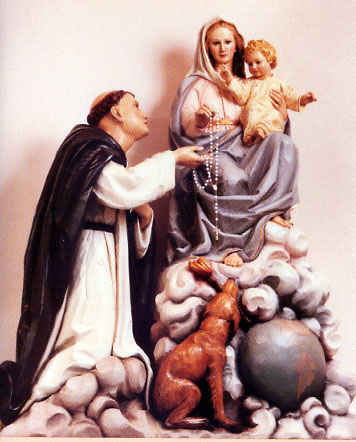Ave Maria Mediations

St. Dominic: Feast Day is August 8th
Tradition associates the origin of the Rosary with St. Dominic as you can see depicted in this painting but it was not exactly the Rosary as we know it today.
Dominic Guzman (1170-1221 AD) was a Spanish priest who in southern France encountered the Albegensian heresy. He was having great difficulty and not very successful in touching hard hearts. But when he began to preach the rosary, he had great success. It was Our Lady’s special devotion and her intercession was strong with its praying.
Tradition tells us that in a vision Mary told him that he should pray the Marian Psalter along with his preaching. The Marian Psalter in the 12th century consisted only of 150 Hail Maries follows:
“Hail Mary, full of grace, the Lord is
with thee, blessed art thou among
women and blessed is the fruit of
thy womb.”
It does not appear that the Our Father was part of the Marian Psalter but the Paternoster or the practice of praying 150 Our Fathers was the earliest way to pray the Psalter for the average person. So, Dominic along with preaching the mysteries of faith lead the people in praying a decade of the Marian Psalter. In this way the grace of God opened their hearts and he brought about many conversions.
The Rosary we have today was not directly given to St. Dominic by Mary. St. Dominic used the Marian Psalter along with his preaching. It was left to the Confraternity of the Rosary promoted by Blessed Alan de la Roche in about 1475 to think over the selection and order of Mysteries in association with the Aves and Paternosters. Since St. Dominic began this process, it is fitting to consider him as the originator of the Rosary.

| Tradition goes on to tell us that: “One day through the Rosary and the Scapular I will save the world” These were the words spoken to Saint Dominic by the Blessed Virgin Mary in the year 1208 when she appeared to him.
“My son,” the Queen of Heaven said, “prayer and penance are the only way to win souls. Pray my Psalter and teach it to your people. That prayer will never fail.” The holy priest frequently prayed the Psalter as he walked along the road. Many people did. Those who could not read Holy Scripture and those who could not understand it often said a Hail Mary for each of the Psalms. Their simple prayer took the place of the one hundred and fifty Psalms of David that the learned ones could read. In 1568 the Our Father and Hail Marys were joined to become the form as we know it today. The ‘Glory-Be to the Father, to the Son, and to the Holy Ghost’ and the ‘O my Jesus’ portion of the Rosary have been added and approved by the Church through the years to arrive at it’s present form as it is prayed today. In Our Lady’s apparitions, she asks the faithful to pray the rosary. Should we not follow the request of the Mother of God! In 2002, Pope John Paul II added the Luminous Mysteries or The Mysteries of Light to the Rosary for the meditation on the public life of Jesus. Many wonderful words have been written on the Rosary, many by the Supreme Pontiffs and also such saints as St. Louis Marie de Montfort. Such a simple request from the Queen of Heaven with so many graces attached to it for souls! Let us never neglect our daily Rosary. |
Directions on how to pray the rosary can be found at http://www.ewtn.com/Devotionals/prayers/rosary/how_to.htm
